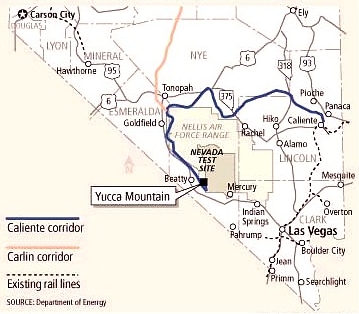Radioactive Waste 237 - Air Force Raises Complaints About Plans To Restart The Yucca Mountain Repository Project
I have blogged about the Yucca Mountain Repository in Nevada for spent nuclear fuel before. The project was cancelled by the Obama Administration in 2009. There is now building momentum for restarting the project. Spent nuclear fuel is accumulating at nuclear power plants around the country and definitely needs to be dealt with.
Stepping back from questions about the safety of the Yucca Mountain site, there is the issue of transporting spent nuclear fuel from all over the country to Nevada for disposal if the Yucca Mountain Repository is actually built. Nuclear materials being transported are especially vulnerable to accidents and terrorists. If work on the Yucca Mountain repository goes forward, it is certain that there will be debates and lawsuits over the routes that the waste will take on the way to Nevada.
Yucca Mountain is in the southwest corner of the almost three billion acre Nevada Test and Training Range (NTTR) operated by the U.S. Air Force. The Secretary of the Air Force has raised issues about the transportation of spent nuclear fuel across the NTTR. She said in an interview with a Las Vegas newspaper “If Yucca Mountain becomes a storage area it needs to operate without impacting the ability of the country to defend itself. There is no route across the NTTR that would not impact testing and training. We do night operations. We train people to go to war. I don’t think my concerns are any different than what has already been expressed by my predecessors. … We still have a very high need to be able to use the Nellis training area for both training and tests.”
In 2003, in response to a proposed Chalk Mountain rail transportation route across the NTTR, the then Secretary of the Air Force wrote to the House Armed Services that such a route would affect mission-critical systems evaluations as well as air combat training. Three quarters of all of the Air Force live munitions testing takes place at the NTTR. The ability of stealth aircraft to evade radar is also tested at the NTTR. He pointed out that any routes along the edges of the NTTR would also cause problems with Air Force testing as would any over-flight restrictions imposed on the NTTR because of spent fuel shipments.
The twelve thousand square mile NTTR is the biggest contiguous air-and-ground space for military training in the U.S. or any of its allies. Unfortunately, due to the increased speed of new military jets, the NTTR is no longer big enough to conduct the necessary tests and the Air Force would like to expand the NTTR, not shrink and/or restrict it which would be the result of the completion of the Yucca Mountain Repository.
If the Yucca Mountain Repository is completed and put into service to dispose of spent nuclear fuel, it will solve one of the major problems of the nuclear power industry. But it will severely impact the ability of the Air Force to test planes and munitions at the NTTR. If the Repository is not built at Yucca Mountain, then the Air Force will be able to continue testing at the NTTR but the spent nuclear fuel will continue to pile up at the nuclear power plants. Either way, there will be pain consequences.
